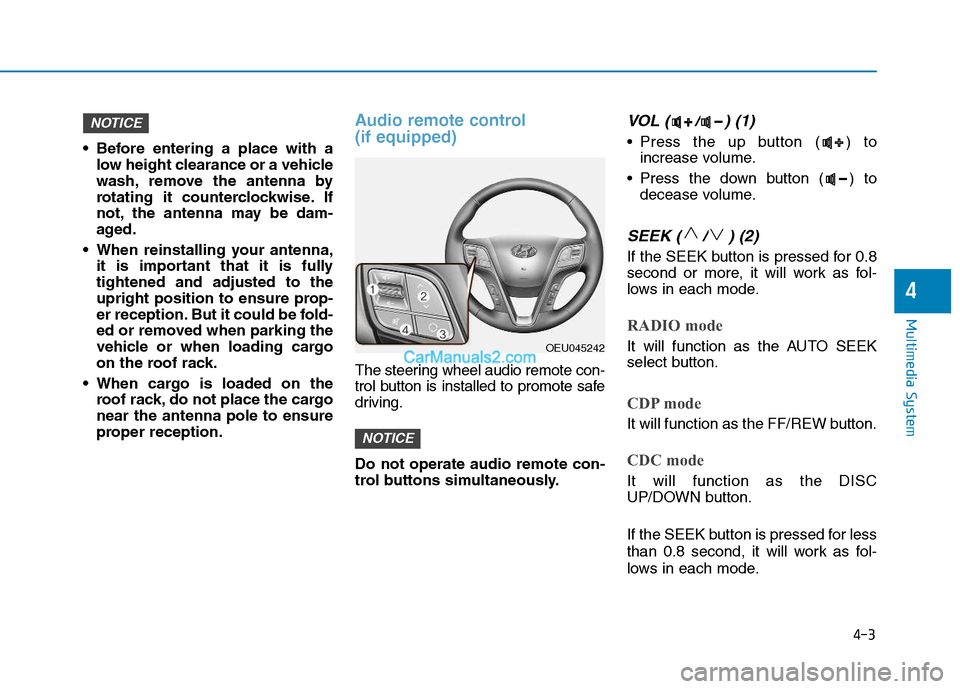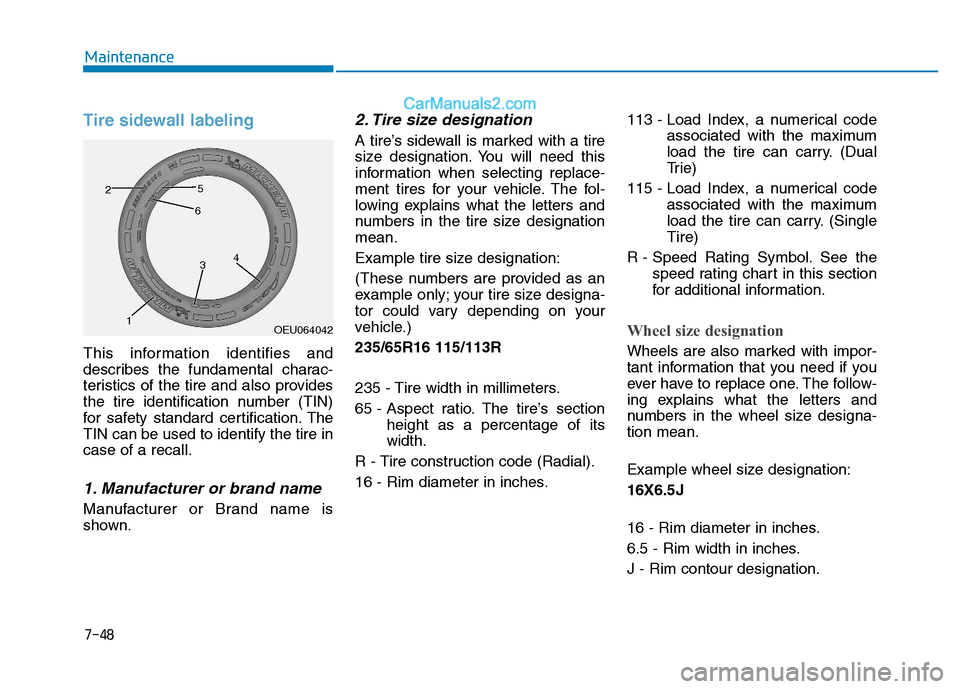2015 Hyundai H350 height
[x] Cancel search: heightPage 153 of 473

3-91
Convenient features of your vehicle
3
Rear parking assist system pre-cautions
The rear parking assist system may not sound sequentially depending on the speed andshapes of the objects detected.
The rear parking assist system may malfunction if the vehicle
bumper height or sensor installa-tion has been modified or dam-
aged. Any non-factory installed
equipment or accessories may
also interfere with the sensor per-
formance.
The sensor may not recognize objects less than 30 cm (11.8 in.)
from the sensor, or it may sense an
incorrect distance. Use caution.
When the sensor is frozen or stained with snow, dirt, or water,
the sensor may be inoperative until
the stains are removed using a softcloth.
Do not push, scratch or strike the sensor. Sensor damage could
occur. This system can only sense
objects within the range and loca-
tion of the sensors; It can notdetect objects in other areas
where sensors are not installed.
Also, small or slim objects, suchas poles or objects located
between sensors may not be
detected by the sensors.
Always visually check behind the
vehicle when backing up.
Be sure to inform any drivers of
the vehicle that may be unfamiliar
with the system regarding the sys-tems capabilities and limitations.
NOTICE
Pay close attention when the
vehicle is driven close to
objects on the road, particularly
pedestrians, and especially
children. Be aware that some
objects may not be detected by
the sensors, due to the object’s
distance, size or material, all of
which can limit the effective-
ness of the sensor. Always per-
form a visual inspection to
make sure the vehicle is clear of
all obstructions before moving
the vehicle in any direction.
WARNING
Page 195 of 473

4-3
Multimedia System
4
Before entering a place with alow height clearance or a vehicle
wash, remove the antenna by
rotating it counterclockwise. If
not, the antenna may be dam-
aged.
When reinstalling your antenna, it is important that it is fullytightened and adjusted to the
upright position to ensure prop-
er reception. But it could be fold-
ed or removed when parking the
vehicle or when loading cargo
on the roof rack.
When cargo is loaded on the roof rack, do not place the cargonear the antenna pole to ensure
proper reception.
Audio remote control (if equipped)
The steering wheel audio remote con-
trol button is installed to promote safe
driving. Do not operate audio remote con-
trol buttons simultaneously.
VOL ( / ) (1)
• Press the up button ( ) toincrease volume.
Press the down button ( ) to decease volume.
SEEK ( / ) (2)
If the SEEK button is pressed for 0.8
second or more, it will work as fol-
lows in each mode.
RADIO mode
It will function as the AUTO SEEK
select button.
CDP mode
It will function as the FF/REW button.
CDC mode
It will function as the DISC
UP/DOWN button.
If the SEEK button is pressed for less
than 0.8 second, it will work as fol-
lows in each mode.
NOTICE
NOTICE
OEU045242
Page 293 of 473

5-22
Driving your vehicle
The ABS continuously senses the
speed of the wheels. If the wheels
are going to lock, the ABS system
repeatedly modulates the hydraulic
brake pressure to the wheels.
When you apply your brakes under
conditions which may lock the
wheels, you may hear a “tik-tik’’
sound from the brakes, or feel a cor-
responding sensation in the brake
pedal. This is normal and it means
your ABS is active.
In order to obtain the maximum ben-
efit from your ABS in an emergencysituation, do not attempt to modulate
your brake pressure and do not try to
pump your brakes. Press your brake
pedal as hard as possible or as hard
as the situation warrants and allow
the ABS to control the force being
delivered to the brakes.A click sound may be heard in the
engine compartment when the
vehicle begins to move after the
engine is started. These condi-tions are normal and indicate that
the anti-lock brake system is func-
tioning properly.
Even with the anti-lock brake sys-
tem, your vehicle still requires suf-
ficient stopping distance. Always
maintain a safe distance from the
vehicle in front of you.
Always slow down when cornering. The anti-lock brake system cannot
prevent accidents resulting from
excessive speeds.
On loose or uneven road surfaces, operation of the anti-lock brake
system may result in a longer stop-
ping distance than for vehicles
equipped with a conventional
brake system.NOTICE(Continued)
Rough, gravel or snow-cov-
ered roads.
With tire chains installed.
On roads where the road sur-
face is pitted or has differentsurface height.
The safety features of an ABS
(or VDC) equipped vehicle
should not be tested by high
speed driving or cornering. This
could endanger the safety of
yourself or others.
Page 410 of 473

7-47
7
Maintenance
Wheel replacement
When replacing the metal wheels for
any reason, make sure the new
wheels are equivalent to the original
factory units in diameter, rim widthand offset.
Tire traction
Tire traction can be reduced if you
drive on worn tires, tires that are
improperly inflated or on slippery
road surfaces. Tires should be
replaced when tread wear indicators
appear. To reduce the possibility of
losing control, slow down whenever
there is rain, snow or ice on the road.
Tire maintenance
In addition to proper inflation, correct wheel alignment helps to decrease
tire wear. If you find a tire is worn
unevenly, have your dealer or otherrepair shops that use qualified tech-
nicians check the wheel alignment.
When you have new tires installed,
make sure they are balanced. This
will increase vehicle ride comfort and
tire life. Additionally, a tire should
always be rebalanced if it is removedfrom the wheel.
A wheel that is not the correct
size may adversely affect wheel
and bearing life, braking and
stopping abilities, handling
characteristics, ground clear-
ance, body-to-tire clearance,
snow chain clearance,speedometer and odometer cal-
ibration, headlight aim and
bumper height.
WARNING
(Continued)
The use of any other tire size
or type may seriously affect
ride, handling, ground clear-
ance, stopping distance, body
to tire clearance, snow tire
clearance, and speedometer
reliability.
It is best to replace all four
tires at the same time. If that
is not possible, or necessary,
then replace the two front or
two rear tires as a pair.Replacing just one tire can
seriously affect your vehicle’shandling.
The ABS works by comparing
the speed of the wheels. Tire
size can affect wheel speed.
When replacing tires, all 4
tires must use the same size
originally supplied with the
vehicle. Using tires of a differ-
ent size can cause the ABS
(Anti-lock Brake System) and
ESP (Electronic Stability
Program) (if equipped) to
work irregularly.
Page 411 of 473

7-48
Maintenance
Tire sidewall labeling
This information identifies and
describes the fundamental charac-
teristics of the tire and also provides
the tire identification number (TIN)
for safety standard certification. TheTIN can be used to identify the tire incase of a recall.
1. Manufacturer or brand name
Manufacturer or Brand name is
shown.
2. Tire size designation
A tire’s sidewall is marked with a tire
size designation. You will need this
information when selecting replace-
ment tires for your vehicle. The fol-
lowing explains what the letters and
numbers in the tire size designationmean.
Example tire size designation:
(These numbers are provided as an
example only; your tire size designa-
tor could vary depending on your
vehicle.) 235/65R16 115/113R
235 - Tire width in millimeters.
65 - Aspect ratio. The tire’s sectionheight as a percentage of its width.
R - Tire construction code (Radial).
16 - Rim diameter in inches. 113 - Load Index, a numerical code
associated with the maximum
load the tire can carry. (Dual
Trie)
115 - Load Index, a numerical code associated with the maximum
load the tire can carry. (SingleTire)
R - Speed Rating Symbol. See the speed rating chart in this section
for additional information.
Wheel size designation
Wheels are also marked with impor-
tant information that you need if you
ever have to replace one. The follow-
ing explains what the letters and
numbers in the wheel size designa-tion mean.
Example wheel size designation: 16X6.5J
16 - Rim diameter in inches.
6.5 - Rim width in inches.J - Rim contour designation.
OEU064042
1
2
34
6
5
Page 435 of 473

7-72
Maintenance
H1H2H3
W1
W 3
W2
Vehicle condition Head light
Fog light
H1 H2 W1 W2 H3 W3
Projection type Without driver
960.5 (37.8) 942 (37) 1,488 (58.6) 1,274 (50.2) 456.5 (18) 1,480 (58.3)
With driver 960.5 (37.8) 942 (37) 1,488 (58.6) 1,274 (50.2) 456.5 (18) 1,480 (58.3)
MFR type Without driver
948 (37.3) 944 (37.2) 1,540(60.2) 1,280 (50.4) 456.5 (18) 1,480 (58.3)
With driver 948 (37.3) 944 (37.2) 1,540(60.2) 1,280 (50.4) 456.5 (18) 1,480 (58.3)
Unit: mm (in)
H1 : Height between the head light (Low beam) bulb center and ground
H2 : Height between the head light (High beam) the high beam bulb center and ground
H3 : Height between the fog light bulb center and ground
W1 : Distance between the two head light (Low beam) bulbs centers
W2 : Distance between the two head light (High beam) high beam bulbs centers.
W3 : Distance between the two fog light bulbs centers
Aiming point
OEU074055-A
Page 455 of 473
![Hyundai H350 2015 Owners Manual 8-2
Specifications & Consumer informationD
D IIMM EENN SSIIOO NNSS
unit : mm (in)
ITEMBUSVA NTr u c k
LongShortLongShort
Overall length
[With rear step]6,195 (243.9)6,195 (243.9)
[6,365 (250.6)]5,515 Hyundai H350 2015 Owners Manual 8-2
Specifications & Consumer informationD
D IIMM EENN SSIIOO NNSS
unit : mm (in)
ITEMBUSVA NTr u c k
LongShortLongShort
Overall length
[With rear step]6,195 (243.9)6,195 (243.9)
[6,365 (250.6)]5,515](/manual-img/35/14886/w960_14886-454.png)
8-2
Specifications & Consumer informationD
D IIMM EENN SSIIOO NNSS
unit : mm (in)
ITEMBUSVA NTr u c k
LongShortLongShort
Overall length
[With rear step]6,195 (243.9)6,195 (243.9)
[6,365 (250.6)]5,515 (217.1)
[5,685 (223.9)]6,167 (242.8)5,724 (225.4)
Overall width
[With outside rear view mirror]2,038 (80.2)
[2,436 (96.0)]2,038 (80.2)
[2,436 (96.0)]2,038 (80.2)
[2,436 (96.0)]2,038 (80.2)
[2,436 (96.0)]2,038 (80.2)
[2,436 (96.0)]
Overall height
Roof panel2,665 (105.0)2,690 (106.0)2,685 (105.7)2,320 (91.3)2,320 (91.3)
Roof hatch2,673 (105.2)----
Electric vent2,777 (109.3)----
A/CON2,856 (111.6)----
Front tread1,712 (67.4)1,712 (67.4)1,712 (67.4)1,712 (67.4)1,712 (67.4)
Rear tread1,718 (67.6)1,718 (67.6)1,718 (67.6)1,718 (67.6)1,718 (67.6)
Wheelbase3,670 (144.5)3,670 (144.5)3,435 (135.2)3,670 (144.5)3,435 (135.2)